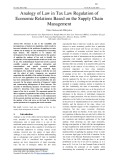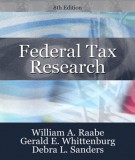
Tax research methodology
-
The relevance is due to the variability and incompleteness of modern tax legislation, which results in increased attention to the problems of applying tax rules with the use of analogy as a key technique for overcoming legal lacunae. The objective is to enhance the development of the doctrinal frameworks for the practice of applying the analogy of law and to identify the peculiarities of the implementation of this tool in the area of tax.
 10p
10p  longtimenosee10
longtimenosee10
 26-04-2024
26-04-2024
 3
3
 1
1
 Download
Download
-
(bq) part 1 book "federal tax research" has contents: introduction to tax practice and ethics, tax research methodology, constitutional and legislative sources, administrative regulations and rulings, judicial interpretations, tax services and periodicals,...and other contents.
 291p
291p  bautroibinhyen27
bautroibinhyen27
 11-05-2017
11-05-2017
 31
31
 3
3
 Download
Download
-
Yet, despite progress in the identification of problems and the development of improved methodologies -- and the possibility of regulatory initiatives that feature mandated environmental accounting -- the field lacks a methodology for evaluating the social and private benefits of improved environmental accounting. Whether regulators continue to motivate EA indirectly via outreach to the private sector, or more directly via incentives such as tax breaks or mandates, private sector resources and regulatory attention should be focused on initiatives that promise the greatest benefit.
 7p
7p  taisaovanchuavo
taisaovanchuavo
 26-01-2013
26-01-2013
 45
45
 4
4
 Download
Download
-
In Figure 1, we plot the ratio of economy-wide after-tax corporate profits to GNP. These data are available in the Survey of Current Business National Income and Product Accounts (NIPA) for 1929 and after (U.S. Commerce 1929—2000). Prior to 1929, we apply the methodology of the Bureau of Economic Analysis (BEA) to construct our own measures of after-tax corporate profits. (See U.S. Commerce 1985 and our Data Appendix for details.) The results are in Table 1. In 1929, the BEA reports after-tax profits equal to 8.8 percent of GNP.
 24p
24p  connhobinh
connhobinh
 07-12-2012
07-12-2012
 38
38
 3
3
 Download
Download
CHỦ ĐỀ BẠN MUỐN TÌM

















